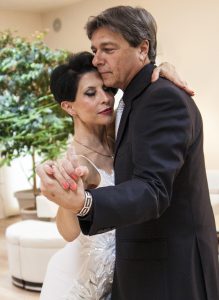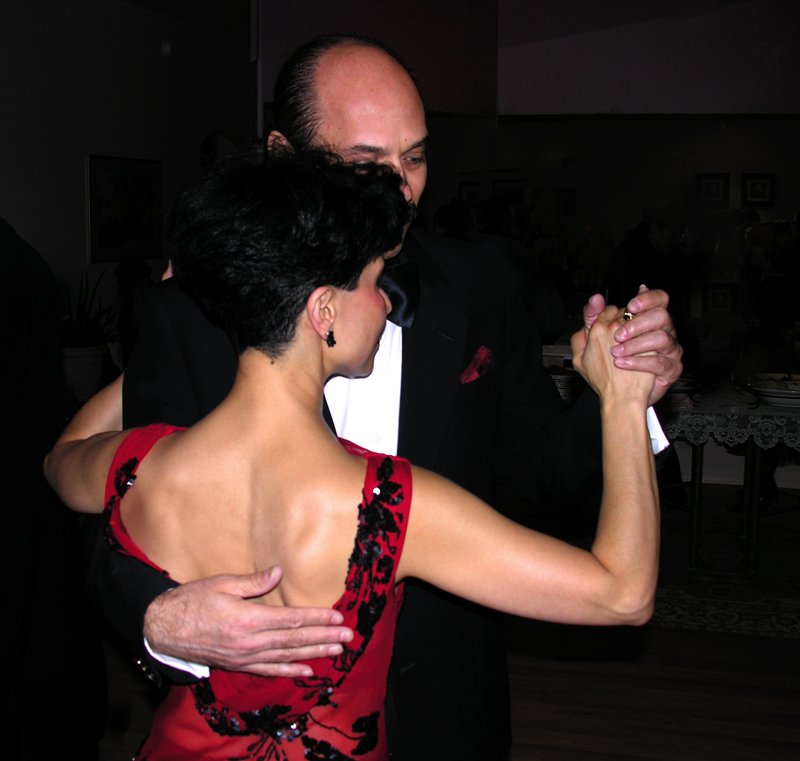DANCE ETIQUETTE
A Concise Argentine Tango Dance Etiquette
Respect … the one with whom you are dancing
Respect … the people around you
Respect … the music and the band
Respect … the culture and heritage of tango
This document attempts to establish a common expectation for social Argentine tango dancing (this can be applied to all forms of social dancing). The suggestions given are to encourage an enjoyable social atmosphere. This is neither a comprehensive list nor rigid governing rules meant to decimate one’s ego. Other than the obvious, the list is non-gender specific.
BEFORE THE DANCE
Personal hygiene is essential for an enjoyable dancing experience. Bad breath, body odor, and excessive perspiration are common offenders. Be sensitive to your fellow dancers. Excessive use of cologne, perfume, or any scented substance can be just as offensive, and never a replacement for bathing.
Dress appropriately for the event. For “milongas,” dress up a little. You cannot go wrong with black; tango is an elegant dance. For “practicas,” dress comfortably and sensibly, but not in an offending way. Be tasteful; avoid displaying body parts not generally acceptable by the public.
Wear shoes with heels to help properly distribute your weight forward; they should also allow you to turn on the ball of your foot with ease –- this applies to the gentlemen as well. If you wear accessories of jewelry, make sure they don’t turn into “assault weapons” while dancing.
If you are interested in dancing, show some desire. Excuse yourself from whomever you are sitting with and stand by the edge of the dance floor to let others know your intentions, if you are with a group or at a table that prevents others from approaching you. Do not expect someone to interrupt your conversation with another person to invite you to dance. Try not to carry on a prolonged conversation if you are close to the edge of the dance floor. Give room to those looking to dance.
Always ask for a dance in the utmost polite manner, whether verbally or non-verbally. It is acceptable for a follower to initiate a dance offer.
If you must decline a dance offer, do so sincerely. It is not an offense to sit out a song or two. Sitting out a song means never to accept an invitation for the same song that you have declined someone else. The best way to decline an offer is not to get one in the first place –- try engaging in activities, like conversation, that deter others from asking.
Gracefully accept any decline to a dance offer. If the same person denied your offers several times within the same event, take the hint that the person may have no interest in dancing with you. One’s presence at a dance event is not an obligation to dance with everyone. This is especially true when the leader and follower ratio is less than ideal.
The leader always escorts the follower onto the dance floor, regardless of who initiated the offer. It is also customary for the leader and the follower to meet up by the edge of the dance floor –- mostly from a non-verbal invitation (Cabeceo).
When proceeding onto the dance floor, do so cautiously. Dancers on the dance floor always have the right-of-way. Never walk across the dance floor while other people are dancing.
DURING THE DANCE
Accepting to dance is an obligation to dance the entire song. One never terminates the dance prematurely, unless there is a significant reason. A person dancing below your expectation is not a significant reason. If you must prematurely terminate a dance, do so without making a scene.
Respect your partner at all times during the dance. It is rather common to dance close in tango but not a requirement. Dancing close is not an invitation for inappropriate behavior. Be sensitive to your partner’s comfort level with their personal space.
Customarily, talking is inappropriate while dancing tango at a milonga. Talk between songs or when off the dance floor. If you must talk on the floor, keep it to a minimum. It is especially inappropriate to talk on the floor while a live band is performing.
Never conduct any teaching or practicing at a milonga; save that for a practica. Under no circumstances should you correct your partner while on the dance floor. Perform any correction during practica, and then, only if requested.
Tango is a traveling (Walking) dance; the line of dance is counter-clockwise. Maintain minimal interruption to the dance flow when dancing at the outer perimeter of the dance floor; move toward the center if you are interrupting the dance flow around the floor.
Respect other dancer’s space. Experiences dancers should give novice dancers the room they need. Novice dancers should stay closer to the center of the dance floor to give experiences dancers their space. Experienced dancers wanting to perform steps that interrupt the dance flow should do so toward the center of the dance floor.
Be conscientious and courteous to your fellow dancers. Avoid bumping into other dancers. If you do, apologize and proceed cautiously. Try dancing in place to reconnect with your partner after bumping into other dancers. Social dance floor is not a stage or a competition ground, it is an intimate place to share with other dancers. Use proper judgement when on a crowded dance floor. Only execute steps that do not violet other dancers’ space. Avoid any steps that can potentially hurt others – this is the time to use your ‘milonguero’ wizardry.
Respect your partner’s dance style. Social dancing means compromising when partners of extreme differences in dancing style dance together. Do not ask or accept a dance offer unless you are willing to compromise.
Respect your partner’s level of dancing. If you are the more experienced dancer, compromise by dancing at your partner’s level.
AFTER THE DANCE
In tango, dancing multiple songs in a row with the same partner is a common practice. If you decide to dance another song, it is not necessary to thank your partner. In Argentina, thanking your partner signifies your desire to conclude the dance. However, in the United States, it is quite common for partners to say thanks between songs. So if you wish to conclude a dance at the end of a song, gesture or discreetly inform your partner that you wish to stop. Never turn around abruptly to leave the dance floor to conclude the dance. If a live band is performing, face the stage and applaud after each song.
The leader always escorts the follower off the dance floor after the dance. Escort the follower back to the original point of rendezvous, extend your gratitude, and walk away gracefully.
Dancing is not a favor you do for someone. The proper response to “thank you” after a dance is to say “thank you,” not “you’re welcome.”

